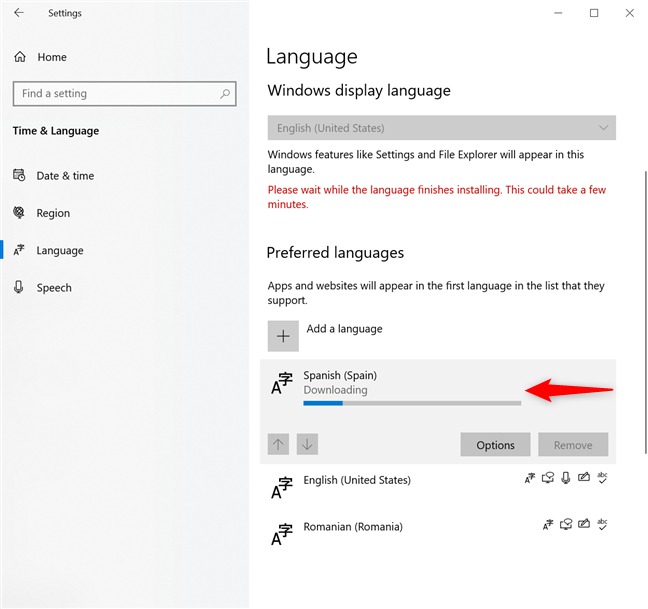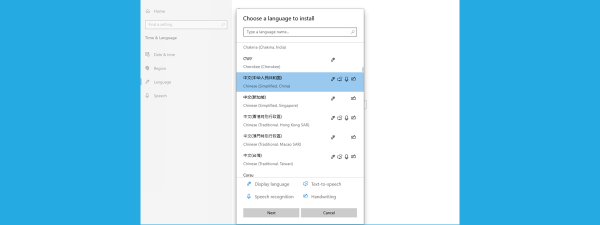
If you just got a new computer or device, you might want to change the language on Windows 10 to one you’re comfortable with. However, to change the Windows display language, you first need the corresponding Windows 10 language pack. At the time this guide is written, Microsoft offers around two hundred Windows 10 language packs that you can download and use, as long as you have a valid license for the operating system. This tutorial illustrates how to change language on Windows 10 from English to Spanish, but you can follow the same steps to change the Windows 10 language to another. On top of that, if you got a Windows 10 computer or device that uses a language you don’t understand, we detail the icons next to every setting to provide the clues you need for changing the language. Let’s get started:
NOTE: This guide was created using Windows 10 October 2020 Update or newer. If you’re running the Windows 10 Home Single Language Edition, you can’t add a language to Windows 10 unless you upgrade to another version. To find out which version and edition of Windows 10 you have installed, read How to check the Windows 10 version, OS build, edition, or type.
How to install a Windows 10 language pack
When you install Windows 10 on your computer or device, you have the option to set its default language. However, you could be dealing with a device configured in a language you don’t understand, or you might want to know how to change the Windows display language for a guest’s profile. In that case, you first need to install a language pack in Windows 10 for the language you want to use. It might sound complicated, but the Windows 10 language settings allow you to complete the Windows 10 language pack download and change the Windows language at the same time.
To begin, open the Settings app. A quick way to do that is to press Windows + I on your keyboard. Then, access the Time & Language section, whose icon features the letter A.

Click or tap on the Time & Language Settings
From the left column, press on the “Language” tab, whose icon also features the letter A. The Windows 10 language settings are shown on the right. Any installed Windows 10 language packs are displayed under Preferred languages. Click or tap on the “Add a language” option next to the plus sign.

Use the Windows 10 language Settings to add a language to Windows 10
This opens a window with all the available Windows 10 languages. You can use the search box at the top or scroll down the alphabetical list to find the Windows 10 language pack you want.
NOTE: If a language is greyed out, then it’s already installed on your Windows 10 device, so go to the next chapter of this guide to see how to change the Windows language.

You can change language in Windows 10 to most of the available options
The fastest way is usually to type the name of the language you need - in our case, Spanish. For some languages, there are more versions available, so you might have to choose the one specific to your region or country. However, before you decide, check what’s included with the Windows 10 language pack you are about to install. There can be up to four symbols next to every available language entry:

In Windows 10, change language to one that includes the features you want
- Display language - The familiar icon featuring the letter A indicates that you can change the Windows display language to this one. The language you select must have this symbol next to it.
- Speech recognition - The microphone symbol lets you know there are speech recognition services available for that language, which means Windows 10 should be able to understand what you’re saying.
- Text-to-speech - As indicated by the computer display and text bubble icon, Windows 10 speaks this language. Only major Windows 10 language packs, like English, Spanish, Chinese, etc., have the Speech recognition and Text-to-speech features.
- Handwriting - The pen-on-paper icon shows that handwriting recognition is available for a language. This option is useful for tablets with pens and touchscreen devices.
TIP: You might notice languages that don’t have any of the four symbols above displayed next to them. While those entries are not viable options for this guide, you can use them to add a new keyboard input language.
After reviewing all the available options, click or tap on the Windows 10 language pack you want to use. Then, press Next - the button on the lower-left corner of the pop-up.

Select the Windows 10 language you want and press Next
The “Install language features” page shows you the available options for the selected language. Make sure the first optional feature - “Install language pack” - is checked, as that’s the one you need to change language in Windows 10. You can also click or tap on the “Set as my Windows display language” option underneath to check it and change the Windows language right away. However, you can also set it later, as shown in the next chapter.
Next, select any other language features you want. Keep in mind that Windows 10 language packs, as well as their optional features, take up space on your hard drive and can end up affecting the overall system performance. So it’s best to only install what you’re going to use.
When you are done checking the options you require, click or tap on the Install button in the lower-left corner.

How to change language on Windows 10 right away
You are returned to the Windows 10 language settings screen, where you can follow the Windows 10 language pack download.

Wait for the Windows 10 language pack download to finish
When the language pack finishes downloading, the selected language is added to the list of languages you can use in Windows 10.
How to change language in Windows 10
There are two possible scenarios to change the Windows language. If you checked the “Set as my Windows display language” option before installing the language pack in Windows 10, you are prompted to sign out when its download is finished. Click or tap on the “Yes, sign out now” option on the left.

Sign out to complete the Windows change language process
However, you are only required to install new Windows 10 language packs once. Afterward, they become available in the Windows 10 language settings, and it’s much easier to apply them and change the Windows display language. Open Settings, go to Time & Language, and access the Language tab again, as illustrated in the previous chapter. Then, click on the field under “Windows display language” - the one displaying your operating system’s current language - to open a dropdown menu. You can now choose between the Windows 10 language packs already installed on your computer or device.

How to change language on Windows 10 when you have the language pack
As soon as you select the language you want, you get the same blue pop-up asking you to sign out. When you sign back in with the same user account, the operating system is displayed in the Windows 10 language you chose.
NOTE: At this point, most of Windows 10 is displayed in the language you selected. However, the sign-in screen, as well as new user accounts, still use the previous language. Don’t worry! After changing the Windows display language to the one you prefer, you can easily translate the Windows sign-in screen into your local language.
How to change the language of apps, websites, and more
When you change the Windows language, it also becomes the default for Windows 10 apps and any websites you visit in Microsoft Edge and other web browsers. However, you can have your operating system use one display language and your apps and websites another. Open the Windows 10 Language Settings once more, and, under Preferred languages, find the name of the language you want to use for apps and websites. Clicking or tapping on any entry reveals two arrows. Use them to move the preferred language for websites and apps to the top of the list and arrange the other language entries. If the first language is not supported, the second one is used, and so on, which is helpful for those working with multiple languages in Windows 10. When you are done arranging everything in your preferred order, close the Settings app.

Use different Windows 10 languages for different elements
From now on, Windows 10 uses a different display language than your Microsoft Store apps and the websites you visit.
Unfortunately, if your language uses special characters, you can encounter problems in some apps. For instance, media players might not be able to use all the characters of your local language, displaying song titles or subtitles incorrectly, which can be annoying. To fix this type of issue, read our tutorial on setting the language of non-Unicode programs in Windows.
If you’re using Microsoft services in your web browser, here’s how to change the language for Outlook, Office Online, OneDrive, and more. You can also change Facebook’s language in your browser in Windows. However, when it comes to Netflix, you can use both a browser or the Windows 10 app to modify your profile’s language, as you can learn from our guide on How to change the language on Netflix.
What Windows 10 language(s) are you using?
After installing the desired Windows 10 language pack(s), you can change the Windows language with just a few clicks or taps. If you’re using multiple languages, like we are, the only downside is having to log out every time. Before you close this guide, we’re curious about the language(s) you’re using in Windows 10. Did you find the Windows language pack(s) you wanted? Let us know in the comments.


 18.01.2021
18.01.2021 

